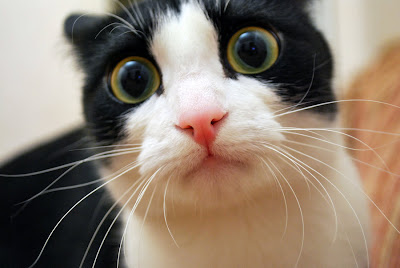Over at the Scientific American Culturing Science blog, they boldy look at the numbers:
Every few months, the fact that domestic cats are ruthless killers hits the news. This past summer it was the Kitty Cam, memorably explained by webcomic The Oatmeal, which saw nearly one-third of cats kill 2 animals each week on average. In 2011 a study found that domestic cats were responsible for nearly half of predation on baby gray catbirds (Dumetella carolinensis), a shy bird common in the mid-Atlantic and named for its cat-like call. And this morning, Nature Communications published a large analysis estimating how many animals are killed by cats annually in the US: 1.4-3.7 billion birds and 6.9-20.7 billion mammals each year.
Let me repeat: every year BILLIONS of birds and mammals are killed by free-ranging domestic house cats, Felis catus. And millions of reptiles and amphibians on top of that.
This is not a cue for you to pat Fluffy on the head and congratulate her for being such a “natural little killer.” These data are no joke. Domestic cats are on the IUCN’s list of the top 100 World’s Worst Invasive Alien Species for their ability to decimate prey populations. Those razor-sharp claws strike the hardest on islands, where animal populations are relatively confined. A 2011 review found that, on islands, cats are the primary cause for at least 14% of bird, mammal, and reptile extinctions and the principal threat to almost 8% of critically endangered animals (2).
The new data drive home the point that, even on large continents, cats can do serious damage. Easily more damage than collisions with buildings or wind turbines do to birds. And, the authors hope, it’s a fact that wildlife management groups will not be able to ignore.
Feral cat populations are out of control–but what can be done about it?
Now we come to the bold part:
The problem is that trap-neuter-release programs don’t work. Cat fertility is so high–a single female can have 3 litters of 4-6 kittens each year–that a just a small percentage of the population needs to be reproductive to make up for the natural death rate. (Even if most of the kittens born end up dying before reproducing.) Additionally, trap-neuter-release isn’t even cost-effective compared to euthanasia, even if all the cat feeding, capturing and neutering is performed by volunteers.
And, meanwhile, all those neutered cats are still doing what they do best: catching and eating small animals.
So the obvious answer then is that, if we value biodiversity and wildlife and can manage to overcome our predilection for cute cat faces over cute bird faces, cat populations should be controlled through humane killing, just like many other invasive species.
Right. But....
But the funny thing is that no one suggests that. In compulsively researching this blog post, I read many papers showing that trap-neuter-release doesn’t work, or studies showing that, in computer models, euthanasia reduces cat populations more effectively than trap-neuter-release. But then in their concluding paragraphs, after providing evidence that current methods aren’t working, the action steps proposed by the authors are: (1) all pets should be neutered and (2) owners should be be better educated so they don’t abandon their cats.
What??
Look, I’m as sentimental as the next person. (I cried for the entirety of Les Miserables.) I love my cat and she gives my life meaning. But I also can admit that the science is staring us in the face. We can’t bear to talk about euthanizing cats because they are so friggin’ cute–but, if we’re honest with ourselves, the best solution to this problem is to kill cats. Kill them, with their cute little faces, their soft fur and their snuggles. Some of the cats need to be dead.
Yep, this is Scientific American. Read the whole thing. I quote so much here only as an antidote to the fact that people are lazy.
.


No comments:
Post a Comment